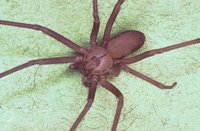Recluse Spiders
|
|
| Recluse spiders | ||||||||||
|---|---|---|---|---|---|---|---|---|---|---|
 Brown recluse spider | ||||||||||
| Scientific classification | ||||||||||
| ||||||||||
| Genera | ||||||||||
The recluse spiders (family Sicariidae) comprise two genera and 122 species [1] (http://research.amnh.org/entomology/spiders/catalog/COUNTS.html), best known being the Brown recluse spider.
Habitat and appearance
The genus Loxosceles is distributed nearly worldwide in warmer areas, and is often known as violin spiders. (Note that the name "violin spider" may also refer to the black recluse, a conjectured species that is believed to exist in the US Pacific Northwest). The Sicarius genus are desert spiders that live in the Southern Hemisphere, (South America and Africa), known primarily for their self-burying behavior.
Both genera have potent tissue-destroying venoms. All have six eyes arranged in three groups of two (diads) and the violin spiders are usually brownish with a darker brown characteristic violin marking on the cephalothorax. Sicarius is crab spider like and lacks this marking. Individual Sicarius can live for as much as 15 years, which makes these among the longest-lived araneomorphae spiders (some tarantulas can live well over 20-30 years.) Most Loxosceles can live for one and a half to two years. Members of both genera can live for very long times without food or water.
The recluse spider family includes about 13 species in the United States. The Brown recluse spider (Loxosceles reclusa) being the best known of these. It is found in a large area of the Midwest, west to Colorado and the New Mexico state line and east to Northern Georgia. Oddly, it has been seldom collected in Florida, and then only as an incidental introduction.
Venom components and effects
The venom of the Brown recluse is highly necrotic in effect, capable of causing lesions (open sores) as large as a US quarter. The wounds take a long time to heal and may require skin grafts. If these open wounds get infected there can be serious consequences. Rarely, the venom is carried by the blood stream to internal organs causing systemic effects. The Chilean recluse (Loxosceles laeta) supposedly has a more potent venom, which results in systemic involvement more often. This spider was accidentally introduced to the Los Angeles area quite a few years ago. Other members of the genus that have been tested have venoms similar to the Brown Recluse and all members of this genus are best avoided. However, the Brown Recluse and its relatives are not very aggressive and huge populations have been found in houses where the human inhabitants were blissfully unaware of their presence!
A possible problem with diagnosing a recluse spider bite is that the bite of these spiders is probably both underreported in some areas and over reported generally. Unfortunately several diseases can mimic the lesions of a recluse spider bite, including Lyme disease, various fungal and bacterial infections and the first sore of syphilis. Therefore it is extremely important to associate the spider directly with the bite, if at all possible.
Generally, recluse spiders are usually found in the center of a sort of space web of fungal-like silk, which often contains the remains of their recent meals. For the Arizona recluse (Loxosceles arizonica) the most abundant food item seems to be night-active ants like carpenter ants. The Brown recluse is known to feed on whatever is available, and this is probably true of all sicariids.
Sicariids live in some of the driest deserts known such as the Atacama Desert of Chile, home of Loxosceles laeta. This ability to live in dry areas, often without food or water, allows recluse spiders to hitchhike on boxes, shipping crates and other materials easily. The genus Sicarius has more toxic venom than Loxosceles, based on laboratory experiments with rabbits. Sicariids are found in such barren deserts and are able to bury themselves partially in the sand, that humans seldom come in contact with them. The females produce egg sacs covered with a mixture of sand and silk. The genus is considered to be a living fossil in that it is both quite primitive and distributed in parts of the former Gondwanaland, the huge southern continent that separated during the Mesozoic. One example of this genus is the six-eyed sand spider, S. Hahnii; whose bite is capable of major systemic damage (and is often deadly). However, bites by this spider are rare.
For pictures of many kinds of spiders, see The Spider Gallery
External links
- Arachnology Home Pages: Loxosceles: Recluse spiders (http://www.arachnology.org/Arachnology/Pages/Reclusa.html)
- Biodiversity Explorer: Family Sicariidae (http://www.museums.org.za/bio/spiderweb/sicariid.htm) (Beautiful photos of Sicarius and Loxosceles!)
- Platnick, N.I. 2003. World Spider Catalog. (http://research.amnh.org/entomology/spiders/catalog81-87/index.html)
- Vetter, R. 2003. Causes of Necrotic Wounds other than Brown Recluse Spider Bites. (http://spiders.ucr.edu/necrotic.html)
- Vetter, R. 2003. Myth of the Brown Recluse Fact, Fear, and Loathing. (http://spiders.ucr.edu/myth.html)
